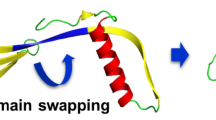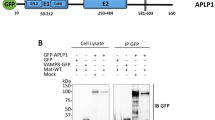Abstract
PROTEASE nexin-II (PN-II) is a protease inhibitor that forms SDS-resistant inhibitory complexes with the epidermal growth factor (EGF)-binding protein, the γ-subunit of nerve growth factor, and trypsin1–3. The properties of PN-II indicate that it has a role in the regulation of certain proteases in the extracellular environment. Here we describe more of the amino-acid sequence of PN-II and its identity to the deduced sequence of the amyloid β-protein precursor (APP)4,5. Amyloid β-protein is present in neuritic plaques and cerebrovascular deposits in individuals with Alzheimer's disease and Down's syndrome6–9. A monoclonal antibody against PN-II (designated mAbP2-l) recognized PN-II in immunoblots of serum-free culture medium from human glioblastoma cells and neuroblastoma cells, as well as in homogenates of normal and Alzheimer's disease brains. In addition, mAbP2-1 stained neuritic plaques in Alzheimer's disease brain. PN-II was a potent inhibitor of chymotrypsin with an inhibition constant Ki of 6 × 10−10M. Together, these data demonstrate that PN-II and APP are probably the same protein. The regulation of extracellular proteolysis by PN-II and the deposition of at least parts of the molecule in senile plaques is consistent with previous reports that implicate altered proteolysis in the pathogenesis of Alzheimer's disease4,5,10–12.
This is a preview of subscription content, access via your institution
Access options
Subscribe to this journal
Receive 51 print issues and online access
$199.00 per year
only $3.90 per issue
Buy this article
- Purchase on Springer Link
- Instant access to full article PDF
Prices may be subject to local taxes which are calculated during checkout
Similar content being viewed by others
References
Knauer, D. J. & Cunningham, D. D. Proc. natn. Acad. Sci. U.S.A. 79, 2310–2314 (1982).
Knauer, D. J., Thompson, J. A. & Cunningham, D. D. J. cell. Physiol. 117, 385–396 (1983).
Van Nostrand, W. E. & Cunningham, D. D. J. biol. Chem. 262, 8508–8515 (1987).
Kang, J. et al. Nature 325, 733–736 (1987).
Ponte, P. et al. Nature 331, 525–527 (1988).
Glenner, G. G. & Wong, C. W. Biochem. biophys. Res. Commun. 122, 1131–1135 (1984).
Kidd, M., Allsop, D. & Landon, M. Lancet i, 278 (1985).
Masters, C. L. et al. EMBO J. 4, 2757–2763 (1985).
Masters, C. L. et al. Proc. natn. Acad. Sci. U.S.A. 82, 4245–4249 (1985).
Abraham, C. R., Selkoe, D. J. & Potter, H. Cell 52, 487–501 (1988).
Tanzi, R. E. et al. Nature 331, 528–530 (1988).
Kitaguchi, N. et al. Nature 331, 530–532 (1988).
Baker, J. B., Low, D. A., Simmer, R. L. & Cunningham, D. D. Cell 21, 37–45 (1980).
Low, D. A., Baker, J. B., Koonce, W. C. & Cunningham, D. D. Proc. natn. Acad. Sci. U.S.A. 78, 2340–2344.
Wagner, S. L., Lau, A. L. & Cunningham, D. D. J. biol. Chem. 264, 611–615 (1989).
Gloor, S., Odink, K., Guenther, J., Nick, H. & Monard, D. Cell 47, 687–693 (1988).
Gurwitz, D. & Cunningham, D. D. Proc. natn. Acad. Sci. U.S.A. 85, 3440–3444 (1988).
Zurn, A. D., Nick, H. & Monard, D. Dev. Neurosci. 10, 17–24 (1988).
Wagner, S. L. et al. Proc. natn. Acad. Sci. U.S.A. (in the press).
Weidemann, A. et al. Cell 57, 115–126 (1989).
Laskowski, M. & Kato, I. A. Rev. Biochem. 49, 593–626 (1980).
Pratt, C. W. & Pizzo, S. V. Biochemistry 26, 2855–2863 (1987).
Palmert, M. R. et al. Science 241, 1080–1084 (1988).
Laemmli, U. K. Nature 227, 680–685 (1970).
Devereux, J., Haeberli, P. & Smithies, O. Nucleic Acids Res. 12, 387–395 (1984).
Wagner, S. L., Van Nostrand, W. E., Lau, A. L. & Cunningham, D. D. Biochemistry 27, 2173–2176 (1988).
Henderson, P. Biochem. J. 127, 321–333 (1972).
Bieth, J. Clin. respir. Physiol. 16, 183–195 (1980).
Author information
Authors and Affiliations
Rights and permissions
About this article
Cite this article
Nostrand, W., Wagner, S., Suzuki, M. et al. Protease nexin-II, a potent anti-chymotrypsin, shows identity to amyloid β-protein precursor. Nature 341, 546–549 (1989). https://doi.org/10.1038/341546a0
Received:
Accepted:
Issue Date:
DOI: https://doi.org/10.1038/341546a0
This article is cited by
-
Bleeding in the brain: Amyloid-β may keep clots away
Nature Medicine (2009)
-
The generation and function of soluble apoE receptors in the CNS
Molecular Neurodegeneration (2006)
-
Dexamethasone diminishes the pro-inflammatory and cytotoxic effects of amyloid β-protein in cerebrovascular smooth muscle cells
Journal of Neuroinflammation (2006)
-
Cell death induced by a caspase-cleaved transmembrane fragment of the Alzheimer amyloid precursor protein
Cell Death & Differentiation (2002)
Comments
By submitting a comment you agree to abide by our Terms and Community Guidelines. If you find something abusive or that does not comply with our terms or guidelines please flag it as inappropriate.



